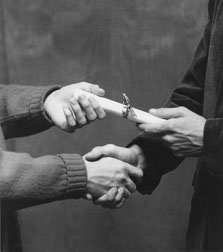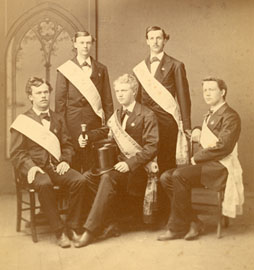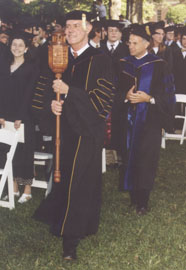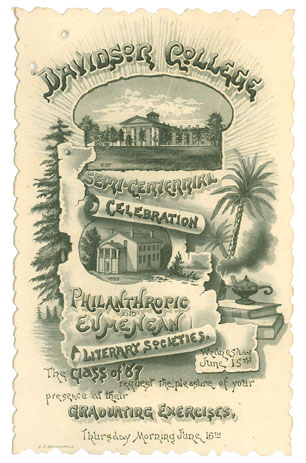Salutatorians at Davidson | Valedictorians at Davidson
“If we look back, the history of Davidson College is soon told. Three years and about five month only have passed, since the first resolution in reference to it was drawn. The prospect of success was then no brighter than a confident reliance upon God’s blessing, and the benevolence of an enlightened and pious people could make it. ”
– Robert Hall Morrison, 1838 commencement address.
Commencement Exercises in the 19th Century
 |
|
[1960s]
11-0333 |
At the Davidson College commencements from 1837-1839, students were not awarded diplomas. Rather they took a Public Examination in the presence of the Trustees and members of the senior class. The local public was invited to observe and did so in droves.
The first of these public exercises at Davidson took place in August 1837, five months after the college opened. Speeches were made by representatives of the newly organized literary societies and an oration was delivered by Major John Beard, Jr. of Salisbury.
In 1838, the commencement was held over three days and included speeches by Sparrow, Morrison, and Brother Thornwell of South Carolina College.
The first graduating exercises with awarding of diplomas held July 1840. By 1842, exercises were most likely held inside Shearer Hall chapel (demolished in 1960 to build the Cunningham Fine Arts Building).
In 1848, the Eumenean and Philanthropic Literary Societies began holding oratorical exercises, usually delivered by the junior class, on the Wednesday before Commencement.
Due to the Civil War, no students graduated in 1862, 1863, 1865, or 1866, though James H. Douglas was awarded a diploma in 1864 for superior scholarship and deportment. In 1867, college held elaborate exercises for a lone graduate: John L. Caldwell.
The next commencement was not held until 1869, with 12 graduates. The graduation speech was delivered by graduate Romulus Tuttle, a Confederate veteran who later became Presbyterian minister.
Until 1881, the Eu and Phi societies planned and paid for commencement ceremonies, expept for the Sunday services. After that point, the trustees allocated of $50 for exercises. Eu and Phi continued, however, to provide marshals to help coordinate commencement.
 |
|
Commencement Marshalls
[June 1874] 11-0133 |
Commencement Celebrations in the 19th Century
Commencement was the college’s major social and public event. Extra trains even ran between Charlotte and Davidson during the week (guests could stay with Mrs. Blair, Mrs. Sparrow, Mrs. Stirewalt, Mr. J.L. Sloan, W.B. Withers, R.A. Brady, and W.P. Williams). Young women came in numbers, dressed in satin, velvet, and lace.
In June 1871, the faculty, upon student request, allowed “Mr. Skinner, a confectioner from Charlotte, to erect… a tent for the sale of ice cream, soda water, and other such palatable and innocuous refreshments.” [Beaty 155]
By June 1889, the faculty allowed both sexes to sit together in Commencement Hall. Promenade Concert was the social high point of the week, when marshals took off regalia and put the over the shoulders of “their best girls.” The society halls were brilliantly decorated and lit, and the prettiest girl who had received the Chief Marshal’s regalia was queened in the President’s chair; this practice ended in 1895, when it was decided that regalia would be returned for use next year, and ladies were given “handsome rosettes” instead. [March 1893 Davidson Monthly]
By 1891, fraternity halls began to rival literary society halls regarding Commencement social activity.
Commencement Exercises in the 20th and early 21st Centuries
 |
|
Grand Marshal Dr. Leland Park holds the college mace.
[18 May 1997] 11-0445 |
The tradition of wearing caps and gowns began in 1903.
Beginning in 1926, the Algernon Sydney Sullivan Awards were given annually at commencement. Two medallions were given, one to a member of the senior class and the other to a member of the Davidson community, to people with fine spiritual qualities who have given unselfish service without due recognition. The award was established by the New York Southern Society in memory of its founder.
In 1962, the college decided that the focus of graduation should be on the deferring of diplomas and began the tradition of not having a graduation speaker. Instead, the President of Davidson College would make brief remarks. Also by this time, commencement was held outdoors whenever possible.
The tradition of selecting a Chief Marshal from the faculty or staff to oversee commencement and to lead the procession dates back to the 19th century. The Chief Marshal’s mace which he or she carries, however, was not added until 1988. The wooden mace is a work of art, decorated with images of Davidson’s mission, history, architecture, and landscape. It was designed and carved by Jack Ramseur, class of 1931.
Beginning in 1992, the first Hunter-Hamilton Love of Teaching Award(s) was given annually at commencement. The award is designed to reward “an exemplary love of teaching.” Dr. James P. Hamilton, Davidson Class of 1954, a physician in Charlotte, and his wife Grey Hunter Hamilton set up a permanent endowment to fund the Hunter-Hamilton Love of Teaching Award, in honor of their late parents: Isabel Reid Hunter, Richard Moore Hunter (Class of 1926), Frances Pressly Hamilton, and Buford Lindsay Hamilton.
 |
|
The first page of a Eumenean and Philanthropic Literary Societies Commencement invitation [1867]
|
Commencement Publications
Commencement programs are believed to have been printed since the founding of the school, but the earliest known program is from 1842. In 1851, the college motto, Alenda Lux Ubi Orta Libertas, appeared in a commencement program for the first time. No programs have been found for Commencements between 1861 and 1869. The programs usually remained simple, undergoing few changes: a one page listing the seniors and addresses, with a simple border decoration. In 1970, the programs had multiple ivory-colored pages decorated with a panel design; this style remained in use for many decades.
The Eumenean and Philanthropic Literary Societies began printing programs for their own oratorical exercises in 1848. After 1870, these programs became very elaborate. The first Commencement invitation is believed to be from 1888. Like the Eu and Phi invitations, these also became elaborate. By 1912, they even came in leather covers. Both programs became simpler in the wake of World War II.
For more information about Commencement programs see Around the D blog: The Honor of your Presence: Commencement Invitations and Programs Throughout the Years.
Commencement – Works Cited
Beaty, Mary. A History of Davidson College. Davidson, NC: Briarpatch P. 1988
Butler, Barbara. “Commencement Programs and Invitations” notes. Commencement Display folder 3.
Davidson, Chalmers G. “Commencement and Commencement Programs.” Commencement Display, Folder 3.
Morrison, Robert Hall. Commencement Address. 1838.
Giduz, Bill. “President Vagt Tells Grads Not to Burst Their ‘Davidson Bubble'” 21 May 2007.
Morrison, Robert Hall. 1838 commencement address.
Wheeler, David. Commencement Display, Folder 2.
Williams, Paige. “Couple to Reward Teaching’s Best at Davidson College.” The Charlotte Observer 3 Nov. 1991.
Author: Tammy Ivins
Date: July 2007
Cite as: Ivins, Tammy. “Commencement at Davidson.” Davidson Encyclopedia July 2007 <https://davidsonarchivesandspecialcollections.org/archives/encyclopedia/commencement-at-davidson/>
Related Entries: Eumenean and Philanthropic Literary Societies, Hunter-Hamilton Love of Teaching Award, Salutatorians, Valedictorians

Sorry, comments are closed for this post.